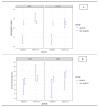Effect of Fortification with Multiple Micronutrient Powder on the Prevention and Treatment of Iron Deficiency and Anaemia in Brazilian Children: A Randomized Clinical Trial
- PMID: 34201821
- PMCID: PMC8308208
- DOI: 10.3390/nu13072160
Effect of Fortification with Multiple Micronutrient Powder on the Prevention and Treatment of Iron Deficiency and Anaemia in Brazilian Children: A Randomized Clinical Trial
Abstract
Fortification with multiple micronutrient powder has been proposed as a public health intervention able to reduce micronutrient deficiencies in children. Our objective was to compare the effectiveness of fortification with multiple micronutrient powder with drug supplementation in the prevention and treatment of iron deficiency and anaemia. This was a cluster trial with anemic and non-anaemic children between six and 42 months old, in randomization data. Non anaemic children received fortification with multiple micronutrient powder or standard drug supplementation of ferrous sulfate associated with folic acid in a prevention dose. Anaemic children who were randomized to receive multiple micronutrient powder also received the recommended iron complementation for anaemia treatment. A total of 162 children were evaluated. The prevalence of anaemia decreased from 13.58 to 1.85%. Iron deficiency decreased from 21.74% to 7.89% (by serum ferritin) and iron deficiency decreased from 66.81 to 38.27% (by soluble transferrin receptor). No difference was identified between interventions for hemoglobin (p = 0.142), serum ferritin (p = 0.288), and soluble transferrin receptor (p = 0.156). Fortification with multiple micronutrient powder was effective in preventing iron deficiency and anaemia in children aged six to 48 months. In anaemic children; it was necessary to supplement the dose of multiple micronutrient powder with ferrous sulfate.
Keywords: anaemia; children; deficiency diseases; iron deficiency; micronutrients.
Conflict of interest statement
The authors declare no conflict of interest.
Figures



Similar articles
-
Home fortification of foods with multiple micronutrient powders for health and nutrition in children under two years of age (Review).Evid Based Child Health. 2013 Jan;8(1):112-201. doi: 10.1002/ebch.1895. Evid Based Child Health. 2013. PMID: 23878126 Review.
-
Multi-micronutrient Sprinkles including a low dose of iron provided as microencapsulated ferrous fumarate improves haematologic indices in anaemic children: a randomized clinical trial.Matern Child Nutr. 2006 Jul;2(3):169-80. doi: 10.1111/j.1740-8709.2006.00060.x. Matern Child Nutr. 2006. PMID: 16881929 Free PMC article. Clinical Trial.
-
The impact of home fortification with multiple micronutrient powder on vitamin A status in young children: A multicenter pragmatic controlled trial in Brazil.Matern Child Nutr. 2017 Oct;13(4):e12403. doi: 10.1111/mcn.12403. Epub 2016 Dec 7. Matern Child Nutr. 2017. PMID: 27925426 Free PMC article. Clinical Trial.
-
Effect of provision of daily zinc and iron with several micronutrients on growth and morbidity among young children in Pakistan: a cluster-randomised trial.Lancet. 2013 Jul 6;382(9886):29-40. doi: 10.1016/S0140-6736(13)60437-7. Epub 2013 Apr 18. Lancet. 2013. PMID: 23602230 Clinical Trial.
-
Micronutrient Supplementation and Fortification Interventions on Health and Development Outcomes among Children Under-Five in Low- and Middle-Income Countries: A Systematic Review and Meta-Analysis.Nutrients. 2020 Jan 21;12(2):289. doi: 10.3390/nu12020289. Nutrients. 2020. PMID: 31973225 Free PMC article.
Cited by
-
Anemia among Syrian Refugee Children Aged 6 to 23 Months Living in Greater Beirut, Lebanon, including the Voices of Mothers' and Local Healthcare Staff: A Mixed-Methods Study.Nutrients. 2023 Jan 30;15(3):700. doi: 10.3390/nu15030700. Nutrients. 2023. PMID: 36771406 Free PMC article.
-
Child-Owned Poultry Intervention Effects on Hemoglobin, Anemia, Concurrent Anemia and Stunting, and Morbidity Status of Young Children in Southern Ethiopia: A Cluster Randomized Controlled Community Trial.Int J Environ Res Public Health. 2023 Apr 5;20(7):5406. doi: 10.3390/ijerph20075406. Int J Environ Res Public Health. 2023. PMID: 37048019 Free PMC article. Clinical Trial.
-
Systematic review on supplementation, fortification, and food-based interventions for preventing iron deficiency anemia in low- and middle-income countries.Asia Pac J Clin Nutr. 2025 Feb;34(1):10-35. doi: 10.6133/apjcn.202502_34(1).0002. Asia Pac J Clin Nutr. 2025. PMID: 39828255 Free PMC article.
-
Long-Term Impact of Multiple Micronutrient Supplementation on Micronutrient Status, Hemoglobin Level, and Growth in Children 24 to 59 Months of Age: A Non-Randomized Community-Based Trial from Pakistan.Nutrients. 2023 Mar 30;15(7):1690. doi: 10.3390/nu15071690. Nutrients. 2023. PMID: 37049531 Free PMC article. Clinical Trial.
-
Prevalence and factors associated with dyslipidemia in children aged 6 to 42 months in a Brazilian capital.Cad Saude Publica. 2024 Sep 23;40(9):e00202123. doi: 10.1590/0102-311XEN202123. eCollection 2024. Cad Saude Publica. 2024. PMID: 39319924 Free PMC article.
References
-
- Stevens G.A., Finucane M.M., De-Regil L.M., Paciorek C.J., Flaxman S.R., Branca F., Peña-Rosas J.P., Bhutta Z.A., Ezzati M., Nutrition Impact Model Study Group Behalf of Nutrition Impact Model Study Group Anaemia. Global, regional, and national trends in haemoglobin concentration and prevalence of total and severe anaemia in children and pregnant and non-pregnant women for 1995–2011: A systematic analysis of population-representative data. Lancet Glob. Health. 2013;1:e16–e25. doi: 10.1016/S2214-109X(13)70001-9. - DOI - PMC - PubMed
-
- World Health Organizaton World Health Data Platform. [(accessed on 4 February 2021)];Prevalence of Anaemia in Children under 5 Years (%) [internet]. Geneva. Available online: https://www.who.int/data/gho/data/indicators/indicator-details/GHO/preva...
-
- Ministério da Saúde (Brasil) NutriSUS. Guia de evidências: Estratégia de Fortificação da Alimentação Infantil com Micronutrientes (Vitaminas e Minerais) em pó. Ministério da Saúde, Ministério da Educação; Brasília, Brazil: 2015. 50p
Publication types
MeSH terms
Substances
Grants and funding
LinkOut - more resources
Full Text Sources

